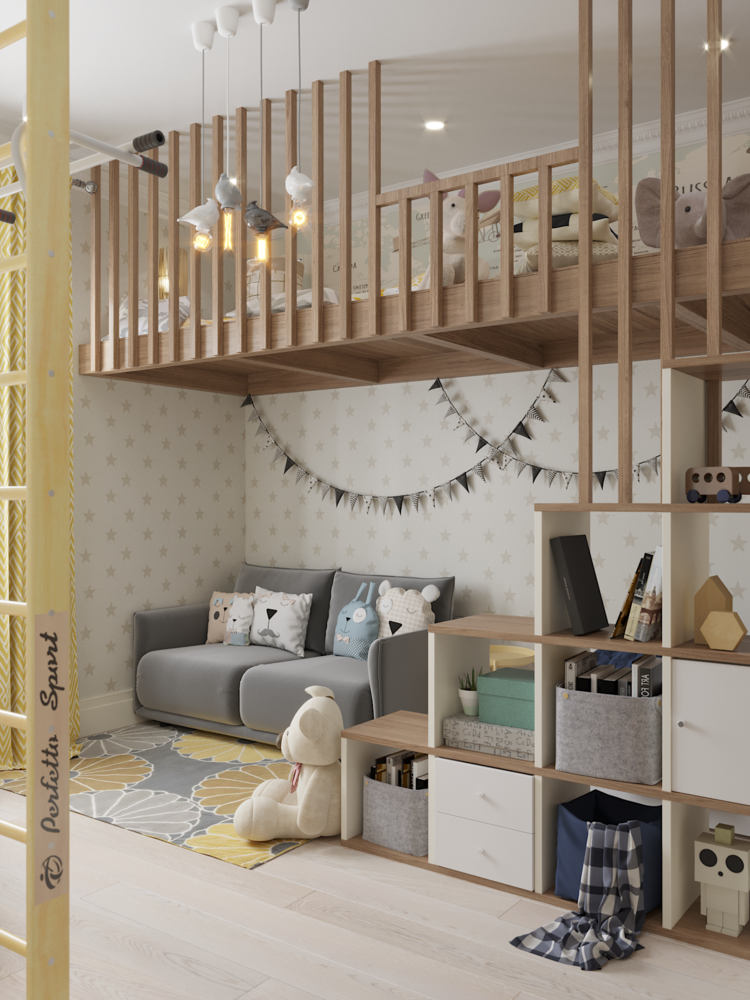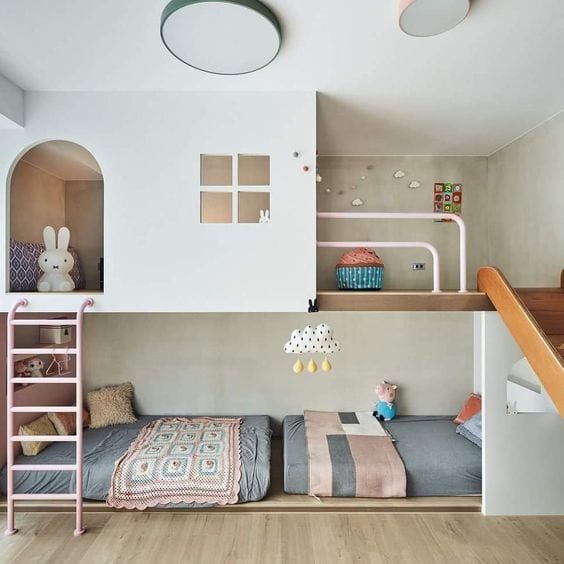Creating a Basement Playground: A Last-Minute Christmas Miracle
On September 24th, Our kid turned 10; she was showered with so many gifts that we ran out of Christmas gift ideas before the season even began! As Christmas came closer, our stress levels rose. What could we possibly get her that she didn’t already have? It seemed like there was nothing left or, at least, nothing you could pick up from a store.
Our little one is very active, always climbing, swinging, and hanging off things. So, with just five days left until Christmas, we had a lightbulb moment. Why not create a basement indoor playground right under the house?
Now, I’d never built anything like this before a basement indoor playground, and trust me, there aren’t many how-to guides online for building a basement playground. So, yeah, we kinda just winged it! We grabbed a stack of 2x4s and got to work, trying to keep things simple by using full-length boards whenever we could and screwing plywood where needed.
Our plan for a basement indoor playground? Build two sturdy playhouses and connect them with monkey bars in the middle. This setup would be strong enough to handle all the climbing and swinging.
Building this basement playground was a true adventure! We squeezed in work whenever we could, whether that meant late nights after bedtime or getting a babysitter over for some help. It took us about five days to put it all together, and a lot of that time was spent gathering materials and making things up as we went. But if you follow the step-by-step guide below, it’ll save you a whole lot of time and guesswork!
Transforming our basement into a playground was one of the best decisions we made, a fun, energetic space where the kids could burn off energy, especially during those long winter days. Plus, it turned out to be the best Christmas gift ever!
Shopping List for Your Basement Playground Build
Here’s a simplified list to help you gather all the materials you need for building your own basement playground from my experience:
1. 2×4 Lumber – Start with about 24 pieces. You might need a few more as you go, depending on your design.
2. 1×4 Lumber – Get around 10 pieces to start.
3. 1×6 Lumber – About 18 pieces should be enough, but you can also use plywood for floors or decking if that’s cheaper.
4. 2×8 Lumber – You’ll need 2 pieces that are 16 feet long and 4 pieces that are 8 feet long. For longer spans, consider using 2x10s or 2x12s, or add cross-bracing for extra support.
5. 1×3 Lumber – Grab 6 pieces to create the little peaked roofs.
6. 1/2″ Plywood Sheets – You’ll need around 6 sheets for various parts of the build.
7. Screws – Use 2-inch and 3-inch self-tapping screws with torque heads. These will save you time since you won’t need to predrill.
8. Monkey Bar Material – Go with 1-inch pipe or 1-inch hardwood dowels, and space them about 12 inches apart for a sturdy set of monkey bars.
This list will set you up to create a safe and fun indoor playground where your kids can climb, swing, and play to their heart’s content!
Best Designed Indoor Playgrounds on the Internet

Note: Prosvirin Design here made a cozy place for kids with this luxe soft fabric. I love the idea of cushioned walls and of course this blush nude color!

Notes: Carl Wooley here went with this bright basement playroom idea and used raw colors for a natural looing Basement indoor Playground. I love the climbing rope! It would be a fun place for the kids to hangout or just chill in here.

Notes: This aesthetic basement playroom would not be hard to create! The planked wood walls sits perfectly here connecting the entire design and tone together.

Notes: This is an incredible work of natural wood with soft colors of purple, green, and gray which is a perfect palate. As per my opinion adding a piece of modern wood hoop is so attractive and such a fun idea to keep indoor basement playground modern and playful.

Notes: This is a very simple and minimal designed style by YesStudio. The seamless wood design is a little too neutral for my taste, but the slide next to stairs add a great design.

Notes: This design by Isabel Lopez Vilaita is very traditional and it aligns with my vision completely. The Ikea storage bins add the class here and the netting top is really fun idea to have.

Notes: This Elena Ivanova kids playroom the best one I have ever seen on net, it is cute and has wooden structures as well as covers on the loft. Perfect for kids.

Notes: Frauline Flora’s basement playroom is very subtle and has everything a kid can ask for. It is exciting and safe at the same time.

Notes: Hao Design made this cute basement playground with little house and wooden slide! I like the pink pipe piece and soft toys placement. I would have added some spray paintings here.

Notes: Tigerplay designed an amazing indoor playground for a client, and I’m absolutely loving it! The purple padded floors, the wooden beams, and the white framework all come together so perfectly. The tunnels and ropes? Such a fun idea for a kids’ gym!

Notes- This indoor play gym is awesome for the bigger kids! Just grab a comfy, durable couch, put up a rock climbing wall, and hang some monkey bars and ropes from the ceiling. It’s a blast waiting to happen!

This kids’ basement playground is super exciting with all the different levels, it’s such a feast for the eyes! Plus, the built-in storage cubes are a great touch.
And for the older kids, this indoor basement playground idea is perfect! Just get a sturdy, comfy couch, add a rock climbing wall, and hang some monkey bars and ropes from the ceiling. It’ll be an adventure zone right at home!

This little play setup is just right for the kiddos! I’ve got to get one of those soft round tubes makes the cutest spot for a cozy reading nook in your basement playground.

Notes: All the different textures in this play loft make it a cool and exciting spot for kids to chill and have fun!

Notes: This indoor basement playground with its neutral colors looks amazing! Did you see that hopscotch mat? It’s adorable. And a lightweight swing would be such a fun touch to add to a play loft!

Notes : Speaking of swings, this kids’ indoor basement playground has two awesome swing ideas! We definitely need to grab a couple of those cocoon swings for the kids they’d love them as your kid’s their own basement playground.

Notes: How cool is this pirate loft by Steve Kuhl in your Basement playground? It’s got a three-level design, and the slide even comes out right by the stairs!
Do share your thoughts on basement playground, how are you planning to transform your basement?
FAQ
Are basements unhealthy to live in?
Basements can be healthy to live in if they’re well-ventilated, dry, and free from mold or moisture issues. Regular maintenance and proper insulation are key to ensuring a healthy living environment.
How to make a fun play area?
To create a fun play area, focus on safety, creativity, and comfort. Use soft flooring, colorful decor, and versatile furniture to foster play. Include interactive elements like a playhouse, art station, or sensory toys to keep kids engaged and entertained.
How do I write a business plan for an indoor playground?
Writing a business plan for an indoor playground involves these key steps:
Executive Summary: Summarize your vision for the playground, including the concept, target market, and financial goals.
Market Analysis: Research the local market to identify demand, competition, and target demographics. Include data on potential customer base and industry trends.
Business Model: Outline how your playground will operate. Describe services (e.g., play structures, birthday parties), pricing strategy, and revenue streams.
Marketing Plan: Detail your strategies for attracting customers. This may include online marketing, local partnerships, promotions, and community events.
Operations Plan: Explain the daily operations, including staffing, facility management, and safety protocols.
Financial Plan: Provide detailed financial projections, including startup costs, operating expenses, and revenue forecasts. Include a break-even analysis and funding requirements.
Appendix: Add any additional information, such as floor plans, permits, or legal documents.
Ensure your plan is clear, realistic, and tailored to your specific market.
Do indoor playgrounds make money?
Yes, indoor playgrounds can be profitable. They generate revenue through various streams such as admission fees, membership packages, birthday parties, and event rentals. Success often depends on factors like location, market demand, facility quality, and effective marketing strategies. Managing operational costs and providing a unique, enjoyable experience can help ensure profitability.
Is a playground a good investment?
Yes, a playground can be a great investment if it’s in a busy area and well-managed. It draws families, creates steady revenue, and benefits the community. Just make sure to do your homework on costs and local demand.
